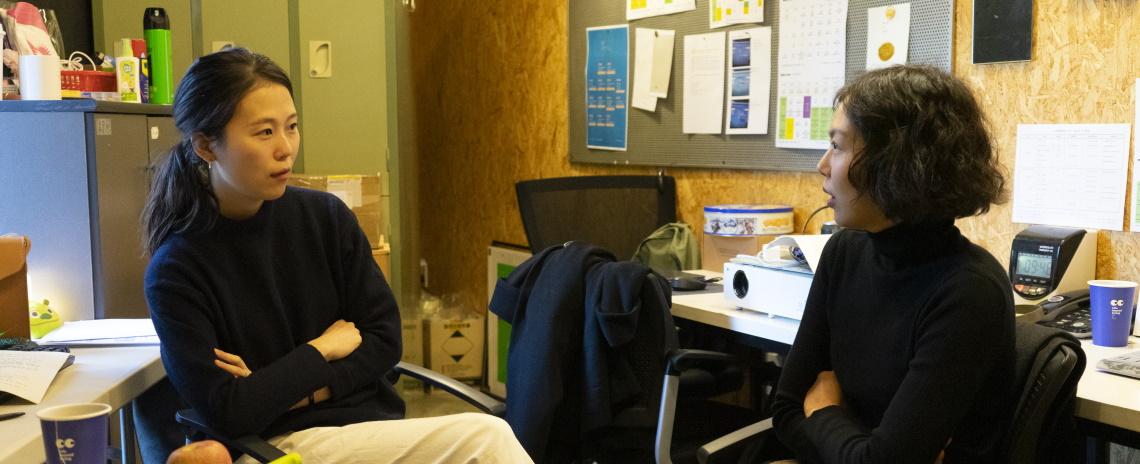Throughout the 30th Annual Whitaker St. Louis International Film Festival (SLIFF), the writers at the Lens will be spotlighting their favorite feature films on this year's festival slate. Our critics will discuss can't-miss festival highlights, foreign gems that have already made an international splash, and smaller cinematic treasures that might have otherwise been overlooked – just in time for you to claim your tickets.
The prolific South Korean filmmaker Hong Sang-soo is fascinated by the microcosmic possibilities inherent in two people talking. In this respect, he takes a page or two from the French New Wave, but Hong has always put his own serene, keen-eyed spin on the act of conversation. He is absorbed with what is revealed and what is hidden; what is stated plainly and what is only wispily implied. His latest film, the lean but deceptively rich feature The Woman Who Ran, could be seen as the apotheosis of this interest. Much of its 77-minute running time consists of just two or three women in a room, exchanging pleasantries, sharing anecdotes, and awkwardly traversing emotionally touchy terrain. The film’s alternate title might as well be Women Talking.
Who the woman referenced in the title might be is unclear, as no one does any running, per se. The film does follow in the steps one specific woman, Gam-hee (The Handmaiden’s Kim Min-hee), as she moves through a triptych of stories. The well-kept wife of a successful translator, Gam-hee takes advantage of her husband’s latest business trip, using it as an opportunity to reconnect with old friends. The first, Young-soon (Seo Young-hwa) lives with a roommate on the outskirts of the city, where they tend to their garden and care for local stray cats. The second, Su-young (Song Seon-mi) is a single, part-time dance choreographer and full-time Pilates instructor who takes pride in her financial and social independence. Gam-Hee encounters her third friend by happenstance, running into the married Woo-jin (Kim Sae-byuk) at a combined café, gallery, and theater space that the woman now manages.
Gam-hee visits with each of these women in turn, talking calmly and pleasantly, usually over food and drink. Compliments are exchanged and current happenings are reported. At first blush, nothing all that significant seems to occur in The Woman Who Ran. One might even say there is barely a story at all. Hong, however, is quite skilled at smuggling secret complexity between the lines of outwardly prosaic social situations. Notwithstanding the filmmaker’s famously actor-centered, semi-improvisational approach to screenwriting, everything about The Woman Who Ran feels fantastically deliberate, from the blocking of shots down to the actors’ vocal inflections. That every conversation is well-honed and yet convincingly naturalistic is a testament to Hong’s talent at bestowing even the most banal moments – the peeling and slicing of an apple, for example – with the weight of meaning.
All three of the film’s sections share structural similarities and parallel conversational beats. The women always eat a meal or snack, prompting appreciation regarding the tastiness of the food. Gam-hee always explains that she and her clingy husband have never been apart for even a day, until his current trip. (She says this with the faintest hint of apology in her voice – or perhaps despair?) At some point, an unwanted man always intrudes on the conversation: a neighbor testy about Young-soon’s feeding of the neighborhood cats; a former one-night stand, now a lovelorn stalker, who shows up on Su-young’s doorstep; and Woo-jin’s husband, a public intellectual who seems to have once had a tumultuous relationship with a much younger Gam-hee.
These men lurk at the margins of Hong’s story, both in the physical and psychological sense – invading, insistent, and unconcerned with what the women want. They never threaten, but something about them seems quietly threatening in a volatile but indefinable way. It is as though their very presence upsets the equipoise that these women have labored so hard to attain in their lives. Sometimes the men are conspicuous simply by their absence: Young-soon, for example, refuses to discuss her ex at all. Sometimes, they dominate the conversation, as when Woo-jin speaks of her husband’s pompous insincerity with mounting contempt.
In the main, however, The Woman Who Ran is a story of feminine spaces and feminine rhythms. (There’s a whiff of queer complication in one segment, discernible when two hands touch for a little too long, but it vanishes with a hasty change in topic.) The film is absorbed with the way that women – particularly bourgeois Korean women – navigate their friendships with other women. Hong illustrates how the smooth pleasantries and politeness of middle-class Korean culture can ooze passive aggression, and how well-intentioned words can both wound the listener and reveal the speaker’s insecurities. Yet this is also a film that deeply admires women: their ability to survive and prosper in a hostile world; their earnest delight when savoring the good things in life; and their talent for saying things without necessarily voicing them aloud.
The Woman Who Ran will be screening at the Tivoli Theatre at 8:45 p.m. on Wednesday, Nov. 10 and at 6:00 p.m. on Friday, Nov. 12.


